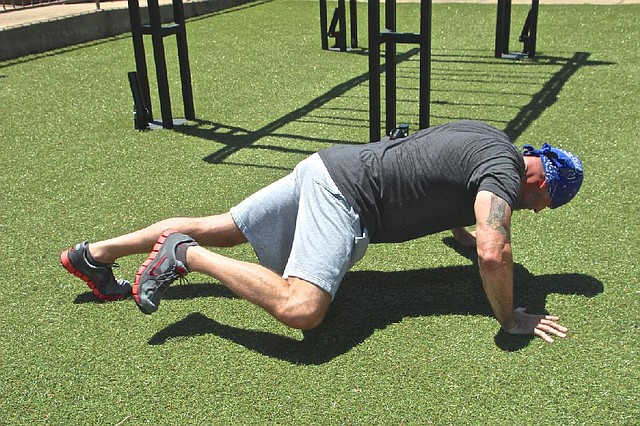Match body-weight exercise to your real level
When standard push-ups become tediously easy, David Chappell shakes things up by lifting one knee toward an elbow, which increases the difficulty. But before you advance to this Spider Push-up, Matt Parrott says, be able to do at least six simpler push-ups on your toes.
Monday, June 24, 2013
Body-weight training can be effective and extremely versatile. The limits imposed by strength machines aren’t relevant when training with your own body weight. It’s a very freeing method of strength training that travels well and can produce solid results.
This week, I’ll present a few keys for body-weight training and introduce an exercise that has become one of my favorite body-weight movements.
Using your own weight as resistance when building muscular strength and endurance is extremely empowering. It gives you a feeling of accomplishment that really doesn’t accompany training with machines or free weights. However, it does take some know how to make body-weight training work for you.
One of the keys to any body-weight exercise is matching the postural position with the desired resistance level. In other words, you need to make sure the movement is not too easy, not too intense for you. This can be accomplished for any body-weight exercise by remembering one simple rule: Before you modify the exercise to make it harder, you must perform six repetitions of the easier version.
If you are unable to perform six repetitions, change the postural position to make the exercise less intense.
This is not to say that you can’t work on the more challenging position, adding an attempt or two as “dessert,” but focusing on the less intense variety will serve you better in the long run.
For example, a push-up can be done a variety of different ways, on the knees, on the toes, feet on a Swiss ball, etc. These different positions will challenge the exerciser in progressively different ways.
For many beginners, a push-up on the knees is a good place to start. As you develop more strength and confidence, moving to a push-up on the toes may be appropriate. But the key is you must be able to perform six push-ups on the toes to justify switching completely to push-ups on the toes. Until that time, maintain the kneeling position for most of your reps and work in one or two repetitions on your toes with each set.
The reason I choose six repetitions as the minimum is simple. Body-weight training is designed to provide a higher degree of muscular endurance as opposed to muscular strength. Therefore, most of the sets should consist of repetition counts in the 12 to 20 range. If you are unable to perform six, you aren’t performing enough repetitions to reach the baseline level needed for building that muscular endurance.
This week’s exercise is designed to challenge those who have performed push-ups for years. It’s a tough version of the standard push-up that requires a unique technique for added difficulty.
Get into the “up” phase of a push-up on your feet and hands.
Slowly lower your torso by bending the elbows.
As you begin lowering your chest, lift your right knee up to try to touch your right elbow. Your right foot will come off the floor as you do this.
Get as close as you can to touching the knee to elbow and then press yourself back up and place the right foot back into the starting position.
Repeat this movement on the left side.
Continue alternating each side for two sets of 15 repetitions.
I think those of you who have mastered the other varieties of the push-up will appreciate this one, because there is a nice core benefit. Enjoy!
Matt Parrott has a doctorate in education (sport studies) and a master’s in kinesiology and is certified by the American College of Sports Medicine.
ActiveStyle, Pages 28 on 06/24/2013
